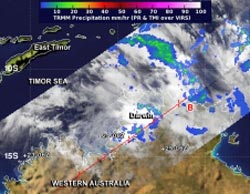NASA Sees Tropical Cyclone Alessia Make Landfall Near Darwin

NASA's TRMM satellite passed over Tropical Storm Alessia on November 24 at 1325 UTC/8:25 a.m. EST and identified mostly light rain from the system (blue) with a small area (green) of moderate rainfall. <br>Image Credit: NASA/SSAI, Hal Pierce<br>
The final warning on the tropical storm was issued on November 24 from the Joint Typhoon Warning Center at 0900 UTC/4 a.m. EST. At that time, Tropical Cyclone Alessia was located near 13.8 south latitude and 129.0 east longitude, about 136 nautical miles/156.5 miles/252 km southwest of Darwin, Australia. Alessia was moving to the east at 15 knots/17.2 mph/27.7 kph and had maximum sustained winds near 35 knots/40 mph/62 kph at the time.
NASA's Tropical Rainfall Measuring Mission or TRMM satellite passed over Tropical Storm Alessia on November 24 at 1325 UTC/8:25 a.m. EST and identified mostly light rain from the system with a small area of moderate rainfall, falling at a rate of 1.18 inch/30 mm per hour.
Cyclone Alessia crossed Australia's Northern Territory coast and made landfall south of Darwin during the night-time hours and quickly dissipated.
The Australian Bureau of Meteorology reported that the Upper Adelaide River, just north of where Alessia made landfall, received tropical-storm-force winds and received about 54 millimeters of rain. No damages were reported.
Text credit: Rob Gutro
NASA's Goddard Space Flight Center
Media Contact
All latest news from the category: Earth Sciences
Earth Sciences (also referred to as Geosciences), which deals with basic issues surrounding our planet, plays a vital role in the area of energy and raw materials supply.
Earth Sciences comprises subjects such as geology, geography, geological informatics, paleontology, mineralogy, petrography, crystallography, geophysics, geodesy, glaciology, cartography, photogrammetry, meteorology and seismology, early-warning systems, earthquake research and polar research.
Newest articles

High-energy-density aqueous battery based on halogen multi-electron transfer
Traditional non-aqueous lithium-ion batteries have a high energy density, but their safety is compromised due to the flammable organic electrolytes they utilize. Aqueous batteries use water as the solvent for…

First-ever combined heart pump and pig kidney transplant
…gives new hope to patient with terminal illness. Surgeons at NYU Langone Health performed the first-ever combined mechanical heart pump and gene-edited pig kidney transplant surgery in a 54-year-old woman…

Biophysics: Testing how well biomarkers work
LMU researchers have developed a method to determine how reliably target proteins can be labeled using super-resolution fluorescence microscopy. Modern microscopy techniques make it possible to examine the inner workings…





















